Romance and Revisions: The Outlaw of Torn by Edgar Rice Burroughs
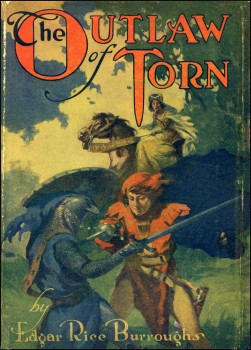 “Not since Arthur of Silures kept his round table hath ridden forth upon English soil so true a knight as Norman of Torn.” –Joan de Tany
“Not since Arthur of Silures kept his round table hath ridden forth upon English soil so true a knight as Norman of Torn.” –Joan de Tany
“I am very doubtful about the story. The plot is excellent, but I think you worked it out all together too hurriedly.” –Thomas Newell Metcalf, letter to Edgar Rice Burroughs, 19 December 1911
“I am not prone to be prejudiced in favor of my own stuff, in fact it all sounds like rot to me…” –Edgar Rice Burroughs, letter to Metcalf, 14 March 2012
In Irwin Porges’s groundbreaking and Chartres Cathedral-sized biography, Edgar Rice Burroughs: The Man Who Created Tarzan (Brigham Young University Press, 1975), only two of ERB’s books have solo chapters dedicated to them: Tarzan of the Apes, of course — and The Outlaw of Torn.
Unless you are a hardheaded Burroughs devotee, I’ll wager a ducat you have never crossed paths with the title The Outlaw of Torn. Considering that chronologically it is squashed between his two most famous books, A Princess of Mars and Tarzan of the Apes, it makes sense that The Outlaw of Torn gets overlooked. That it belongs to the genre of Medieval Romance, a mite mustier than high Martian adventure or swinging times in the African rainforest, compounds the issue.
But this Middle Ages adventure deserves the primacy that Porges awarded it. Burroughs’s second novel taught him hard truths about the business of writing and what he was capable of. ERB was one of the first writer-businessmen; the long labor getting his second book to work and sell schooled him in the reality of making a living as an author of popular adventure.
The Outlaw of Torn also turned out, after all the toil put into it, a flat work manufactured too obviously as a copy of earlier romances. Burroughs thought highly of the book, and in 1927 wrote to his publisher: “I think it is the best thing I ever wrote, with the possible exception of Tarzan of the Apes, and next to it, I believe will rank The War Chief of the Apaches.” But instead of embracing further stories in this style, Burroughs turned and ran for the jungle with his next outing. A lesson learned, even if he could not admit it years later.
The concept for the book came from Thomas Newell Metcalf, the editor at Munsey’s Magazines, who purchased A Princess of Mars (then going by its magazine title, “Under the Moons of Mars”) in 1911. Metcalf recognized a major talent emerging in this chap from Chicago, and suggested Burroughs try “a serial of the regular romantic type, something like, say ‘Ivanhoe’, or at least of the period when everybody wore armor and dashed about rescuing fair ladies.” The editor thought his new discovery might do well in this tried-and-true genre, even though Metcalf had just purchased an unclassifiable planetary adventure from him. Burroughs, thinking a second sale was guaranteed, leaped into creating His Own Private Ivanhoe.
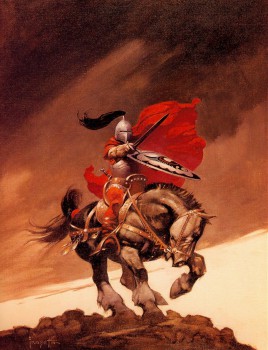 A scant three weeks later (Burroughs’s answer to Metcalf’s letter was to send a complete manuscript to his desk), Metcalf rejected The Outlaw of Torn. This sent ERB into a spiral of revisions and attempts to satisfy the editor, all which came to nothing. He eventually sold the manuscript to A. L. Sessions at New Story magazine for $1,000.
A scant three weeks later (Burroughs’s answer to Metcalf’s letter was to send a complete manuscript to his desk), Metcalf rejected The Outlaw of Torn. This sent ERB into a spiral of revisions and attempts to satisfy the editor, all which came to nothing. He eventually sold the manuscript to A. L. Sessions at New Story magazine for $1,000.
The final published version of The Outlaw of Torn begins with the pseudo-ERB making his second appearance, presenting the story as a manuscript discovered in Europe. Burroughs added this framing device in later revisions, but it fits with the rest of his body of work. It also allows for wiggle room with historical events, since the narrator excuses most of those pesky details from his account: “In the retelling of it I have left out most of the history.” That’s one way to toss out research; Burroughs did write the first draft in a hurry.
It takes only a single chapter for Burroughs to cement his “History? Whatever!” approach when he has thirteenth-century fighters using rapiers and foils in the art of “fencing,” confusing the Middle Ages with Early Modern Europe. Similar anachronisms appear in clothing and headgear as well throughout the book. There’s also a loose use of monetary units (“zecchins”?) and a general tone that feels nothing like medieval England, but more like a silent movie version of it.
Burroughs had more reason to ignore historical realism aside from just making the writing move quicker. He acknowledged that he romanticized his hero for the sake of readability: “If I had written in to Outlaw of Torn my real conception of the knights of the time of Henry III you [Metcalf] would have taken the Mss. with a pair of tongs and dropped it into the furnace. I made my hero everything that I thought the men of the time were not.”
The non-real year is 1243, during the middle of the long reign of King Henry III of England. The king, for reasons unexplained (“Never mind the quarrel, that’s history.”) accuses nobleman Simon de Montfort, Earl of Leicester, of treason. De Montfort — an historical figure — retorts by calling the king a coward and storming off. Instead of banishing or executing de Montfort, like any bloodthirsty Plantagenet monarch would, King Henry takes out his frustrations on his fencing master, the Parisian Jules de Vac. De Vac swears he will have revenge for the insolence of this English swine king!
De Vac’s plan relies on using Henry’s young son Richard, a figure forgotten to history because Burroughs invented him. De Vac kidnaps the child prince, killing Richard’s minder and her suitor while doing so. De Vac and the boy vanish, and the prince’s whereabouts remain a mystery to King Henry and his court for twenty years.
Young Richard grows up in the Derby Hills, unaware of his true identity and name. De Vac trains him in the arts of the sword and hating Englishmen. At age fifteen, the youth encounters and kills three of Henry’s knights who almost discover the prince’s identity. (One of the knights is “Greystoke.” ERB makes a mental note.) De Vac now tells the young man that he is actually “Norman of Torn,” foe of all Englishmen. The newly named man dons armor, his visor always lowered at De Vac’s orders — and to avoid ending the story too soon — and rides forth to strike terror in the hearts of the English!
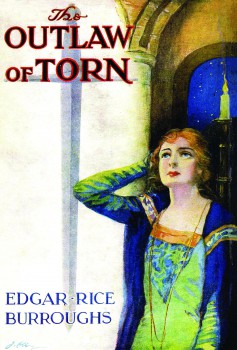 Since a Romantic hero needs chivalry, something De Vac can’t offer, the figure of the kind old priest Father Claude appears to furnish Norman of Torn with knightly attributes. Norman gathers a crew of highwaymen to form a band to wage a bandit’s war against King Henry and all highborn English. A confusing time slip has the story jump ahead to describe Norman’s campaign and growing power in the battle between the King and his barons, and then two pages later hop back to the forming of the band. This feels like an amateur writer’s mistake, or Burroughs trying too hard to embroil the characters in wide-scale adventure before they actually do anything.
Since a Romantic hero needs chivalry, something De Vac can’t offer, the figure of the kind old priest Father Claude appears to furnish Norman of Torn with knightly attributes. Norman gathers a crew of highwaymen to form a band to wage a bandit’s war against King Henry and all highborn English. A confusing time slip has the story jump ahead to describe Norman’s campaign and growing power in the battle between the King and his barons, and then two pages later hop back to the forming of the band. This feels like an amateur writer’s mistake, or Burroughs trying too hard to embroil the characters in wide-scale adventure before they actually do anything.
Norman of Torn soon has a thousand men under his command — a far-fetched leap — and in Robin Hood fashion he refuses to torment the serfs, targeting only the wealthy English. He rescues a woman on the road who turns out to be Simon de Montfort’s (fictional) daughter, Bertrade. Norman decides to keep his identity as the famous outlaw a secret from her, and calls himself Roger de Condé. He falls in love with her immediately, although he keeps the news from himself.
De Vac, whom the text almost exclusively and repetitively describes as “the grim, gray man” after the first few chapters, needs to stop his protégé’s slide toward romance and goodwill. He anonymously helps Bertrade’s frustrated suitor Peter of Colfax kidnap the girl from the road, and leaves behind clues blaming the attack on men from Torn. Bertrade shows herself resourceful in captivity and temporarily turns the tables on Colfax, but this is all a pointless plot cul-de-sac. Norman goes ahead with the rescue, of course.
In his Peter of Condé guise, Norman swears his love to Bertrade, and she to him, but this is an Edgar Rice Burroughs novel, so of course the hero tells her that they can’t be together “and-I-can’t-tell-you-why-so-just-deal-with-it.” But Simon de Montfort plans to betroth Bertrade to Prince Philip of France; the nobleman sends Bertrade over the water and out of Peter/Norman’s reach. A year passes, and Norman of Torn leans his forces to the side of the barons rebelling against King Henry, setting up his eventual turn to the full hero who will reject the vengeful destiny that De Vac tried to chart for him.
ERB was still swimming in unfamiliar waters as a novelist, working on only his second book and still uncertain of his own style. Writing about a fantastic version of Mars freed him to craft what he liked, but The Outlaw of Torn carries the burden of a century of historical romances. The dialogue is thick with attempts at period flavor via Shakespearean flourishes (“Unhand me, sirrah!”) and overstretched speeches packed with “Ye Olde Ynglish” words that weigh as much as a mail shirt: “Silence, old hag … Is it not enough that you leech me of the good marks of such a quantity that you may ever after wear mantles of villosa and feast on simnel bread and malmsey, that you must needs burden me still further with the affliction of thy vile tongue?” I think he made his point with “Silence, hag!”, but ERB was trying too hard to give what he expected readers wanted from an historical romance. He uses phrases and words like “you wot,” “sumpter beast,” and “nathless” with a heavy artificial hand.
Chapter XIII, approximately the two-third’s point, marks the first place in the novel where Burroughs feels comfortable with events: Norman of Torn tries to escape from imprisonment in the castle of the Earl of Buckingham, and finds Joan de Tany, a noblewoman who has already fallen hard for Norman in his Roger de Condé disguise. While dealing with their confused emotions — the first romantic triangle of ERB’s writing career — they find their way through caverns beneath the castle to freedom. The compressed location fits Burroughs’s natural style, and he suddenly dumps the artificial prose and becomes the sleeker action writer we love today. The dialogue remains the same stilted “Oh would that yea knew!” stuff, but it’s progress.
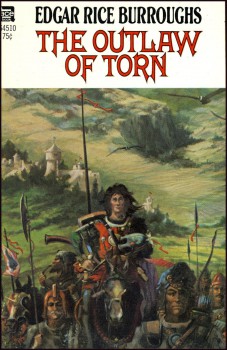 The tension between Norman (as Roger) and Joan works even though Norman’s thoughts keep trying to defeat it with his pure chivalry and undying love for unreachable Bertrade. We know Burroughs won’t break up the established true love between Norman and Bertrade, but the maiden voyage into this kind of romantic tangle is more interesting than the bland baronial revolution and the broader English canvas that Burroughs seems to want to rush through. He even brings the romance with Joan to a nasty conclusion right as it appears on the edge of getting the flippant dismissal that often occurs in other ERB books. The end of this romantic tangle is the biggest and best jolt in The Outlaw of Torn.
The tension between Norman (as Roger) and Joan works even though Norman’s thoughts keep trying to defeat it with his pure chivalry and undying love for unreachable Bertrade. We know Burroughs won’t break up the established true love between Norman and Bertrade, but the maiden voyage into this kind of romantic tangle is more interesting than the bland baronial revolution and the broader English canvas that Burroughs seems to want to rush through. He even brings the romance with Joan to a nasty conclusion right as it appears on the edge of getting the flippant dismissal that often occurs in other ERB books. The end of this romantic tangle is the biggest and best jolt in The Outlaw of Torn.
The story moves into its finale with Norman losing his hatred of all things English through his love for Bertrade; he sides with the baronial revolt against King Henry even after the king offers him a pardon because the outlaw inadvertently saved the life of Queen Eleanor. The writing starts to shed its archaic turns of phrase, although never completely, and the large Battle of Lewes in Chapter XVI is an action highlight. Burroughs follows it up with a gruesome duel that has a vibrancy no earlier crossing of swords in the book has; it’s ERB getting his bearings at a late stage. However, the drama never recovers to the level of tension in the Joan de Tany episode. Even the baronial rebellion amounts to nothing, forgotten at the end in the wrap-up.
In a running theme, ERB struggles with getting his main villain to work. De Vac makes a nonsensical and boring main bad guy. That his name vanishes entirely to be replaced with “the grim, gray man” shows how colorless the character is. The repetition of the phrase eventually becomes flat-out hilarious. De Vac’s motivation and long-game just can’t support the story, and his attempts to manipulate events to make sure that Norman of Torn fulfills his plot to get revenge on King Henry for slapping him come across as pedestrian.
Thomas Newell Metcalf made a few boneheaded decisions in rejecting early Burroughs manuscripts, most damning the choice to bounce The Return of Tarzan. (What was he thinking?) But with Outlaw of Torn, the editor had good reason to feel let down, even if it was his idea in the first place to suggest this kind of book. Despite the twist with Joan of Tany and a well-crafted action conclusion, The Outlaw of Torn feels stodgy and drearily artificial; it lacks the zest of the best of Burroughs’s work, and his own writing style is subsumed under the attempt to create a noble, overly-stylized romance.
One of Metcalf’s comments spikes home to a trouble Burroughs often had: “When you are not using any one of any number of your characters you sort of lay them away in a drawer, so to speak, and seem apparently to forget all about them.” De Vac suffers from this, even after Burroughs revised the story to make the character a more continuous presence. De Vac’s opposite, the pastoral Father Claude, also feels conspicuously absent for long stretches.
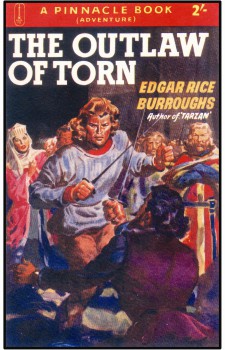 Burroughs worked at re-tooling the novel to Metcalf’s liking, trying two different endings, one happy and one downbeat. The editor still rejected the manuscript, although he made an offer to purchase the plot for a hundred dollars and have one of the magazine’s editors re-write it. Thankfully, Burroughs turned the proposal down: it was too little compensation considering the time he had put into the project, and he had confidence in his talent. He stayed defiant in his last letters to Metcalf regarding his medieval adventure: “I really think your readers would have liked that story…. I tried the Mss on some young people; extremely superior, hypercritical young people, and some of them sat up all night reading it.” When A. C. McClurg released the book in hardcover in 1927, the first printing of 5,000 copies sold out in a month; Burroughs must have felt he had finally won the war, although it took fifteen years of fighting.
Burroughs worked at re-tooling the novel to Metcalf’s liking, trying two different endings, one happy and one downbeat. The editor still rejected the manuscript, although he made an offer to purchase the plot for a hundred dollars and have one of the magazine’s editors re-write it. Thankfully, Burroughs turned the proposal down: it was too little compensation considering the time he had put into the project, and he had confidence in his talent. He stayed defiant in his last letters to Metcalf regarding his medieval adventure: “I really think your readers would have liked that story…. I tried the Mss on some young people; extremely superior, hypercritical young people, and some of them sat up all night reading it.” When A. C. McClurg released the book in hardcover in 1927, the first printing of 5,000 copies sold out in a month; Burroughs must have felt he had finally won the war, although it took fifteen years of fighting.
The battle over Outlaw of Torn taught Burroughs two important lessons. The first was that, although rescuing damsels in distress was a swell plot device for him, it was better to do it in his own imaginative settings than mired in Sir Walter Scott-land. He was too eager to please at this early phase, and unaware of his strengths. Through the struggle getting the book published, he learned those strengths were not in the historical novel.
Burroughs’s second lesson from The Outlaw of Torn was that it was not worth his time to continually revise a work to please a single editor. ERB was a great writer, but he was also a practical man — an “Efficiency Expert” — who didn’t want to expend effort for minimal pay-off. After the experience trying to get Metcalf to buy this one story, Burroughs would never again trap himself in revisions; he either sold the work to someone else or stuck it in the drawer.
Burroughs was an innovator, not an imitator (except of himself in his winding-down years); The Outlaw of Torn is an early stumble at imitation and its faults emphasize that Burroughs needed to forge his own methods outside of what was expected from contemporary genre literature. Trying to sound like what he thought was popular, and at the request of an editor, made him turn out a mostly lifeless work. As Porges sums up in his chapter of his ERB biography dedicated to The Outlaw of Torn:
From a businessman’s standpoint, as balanced the long hours of revision and research against the net return, Ed undoubtedly considered “The Outlaw of Torn” to be a poor investment. Still, he had gained the satisfaction of another sale and had demonstrated the power of sheer stubbornness. Above all, through his unhappy experience with medieval times, castles and knighthood, he had learned that the historical romance, with its emphasis on realistic atmosphere, was not the best outlet for his talents.
There was a happy ending to The Outlaw of Torn ordeal, aside from Burroughs eventually managing to sell it: the experience forged an even higher creative drive in the author. The next time he set down to write a story, he took the kernel of his medieval romance — a young English nobleman unaware of his identity who is brought up in a foreign environment — and retooled it to fit his wilder sense of adventure: Tarzan of the Apes.
Ryan Harvey is one of the original bloggers for Black Gate, starting in 2008. He received the Writers of the Future Award for his short story “An Acolyte of Black Spires,” and his stories “The Sorrowless Thief” and “Stand at Dubun-Geb” are available in Black Gate online fiction. A further Ahn-Tarqa adventure, “Farewell to Tyrn”, is currently available as an e-book. Ryan lives in Los Angeles. Occasionally, people ask him to talk about Edgar Rice Burroughs or Godzilla in interviews.
His Own Private Ivanhoe. You just made my reading day.
I finished reading this last week, the paperback copy with the Frazetta cover. You can mail me my ducat. I don’t recall the book mentioning rapiers, though. And I believe the reference to ‘foils’ was only in regard to wooden practice swords, so I’m not sure that is truly anachronistic. But overall, not a great book. A melodrama featuring stock characters.
I have it; it’s part of the “get-around-to-it-eventually-non-series-Burroughs” group. (SEE ALSO: Marcia of the Doorstep and Mindoka)
[…] him the idea of where to start the next book. After Metcalf rejected Burroughs’s second novel, The Outlaw of Torn, he urged the author to return to Mars and send John Carter into the Valley of Dor, the mysterious […]
[…] needed a touch more practice before he perfected his action formula. (Not much, since after writing The Outlaw of Torn, his next novel, Tarzan of the Apes, shows a writer practicing his craft at near perfection.) There […]
[…] books.) There are also various movie projects kicking around: a complete screenplay adaptation of The Outlaw of Torn has toured Hollywood. Unfortunately, the word right now is that the Ridley Scott Robin Hood has […]
[…] and drearily artificial; it lacks the zest of the best of Burroughs’s work” in his feature review. And Ryan has rarely steered me wrong. I suspect he’d suggest a different book for my […]
I don’t know, enjoyed this book. The beginning is excellent and ending is great even though the middle portion sags with too many royal sounding names.